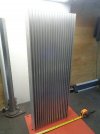- Joined
- Nov 22, 2018
- Messages
- 1,137
- Likes
- 1,513
Reconsider this starting from the speaker's frequency response at 2.83V. We often call that "1-watt sensitivity," but the actual power into the speaker depends on the impedance at each frequency.
When an amp can produce 28.3Vrms at a given frequency, it can play 20dB louder than the "1-watt" output. If low impedance at a different frequency limits the output to 20Vrms, max SPL drops by 3dB at that point on the curve, even if the amp's providing more power.
When an amp can produce 28.3Vrms at a given frequency, it can play 20dB louder than the "1-watt" output. If low impedance at a different frequency limits the output to 20Vrms, max SPL drops by 3dB at that point on the curve, even if the amp's providing more power.

